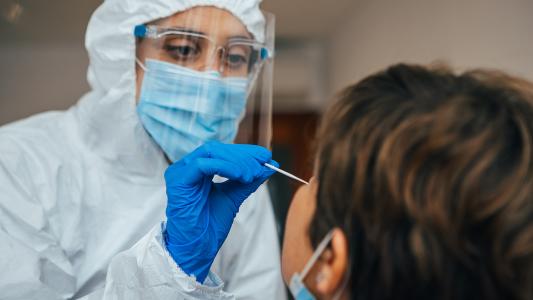Look, it’s brutally hard to kill a fungal infection, and the risk of collateral damage is very high — just ask HBO’s Pedro Pascal.
But contrary to the fictional scientists in Pascal’s The Last of Us — who solemnly inform the audience that there are “no treatments, no preventatives, no cures” for fungal infections — it is possible to fight back against these bizarre invaders. It’s just very, very hard.
Fortunately, a new antifungal compound has been discovered by researchers at Germany’s Leibniz Institute for Natural Product Research and Infection Biology (Leibniz-HKI).
Despite what The Last of Us says, there are antimycotic compounds that fight fungal infections — it’s just really, really hard to make them, and fungi are developing resistance to the ones we do have.
Made by bacteria, these antimycotic — fungus-fighting — lipopeptides were so effective at killing two common types of fungal infections that the team was inspired to bestow upon them a lethal name.
“The lipopeptides kill so efficiently that we named them after Keanu Reeves because he, too, is extremely deadly in his roles,” said Sebastian Götze, a postdoc at Leibniz-HKI and first author of the study, published in the Journal of the American Chemical Society.
The keanumycins are capable of killing fungi that infect both plants and humans, and, reflecting the hero’s concern for collateral damage, they appear to not be too damaging to plant or human cells — making them a possible antimycotic for both crops and clinics.
A deadly cousin: The reason why it’s tough to develop drugs for fungal infections is, simply put, that old arch-villain quip: we’re just not so different, you and I.
Whereas a bacteria or virus is easy to distinguish from our own cells, fungi are also eukaryotes, making us much closer to each other at the cellular level than, say, the virus’s genes-in-a-shell set up. The similarities between our cells and the fungal cells mean that many antimycotic drugs will kill or do damage to both — obviously not ideal.
It’s so difficult that a new class of antimycotic drugs only make it to market roughly every couple decades, as Maryn McKenna noted in Scientific American. (Hopefully, this makes us due any year now — the last new drug to cross the finish line came out in 2001.)
“We have a crisis in anti-infectives. Many human-pathogenic fungi are now resistant to antimycotics – partly because they are used in large quantities in agricultural fields.”
Sebastian Götze
In addition to the inherent difficulty of drug development — and lack of broader scientific interest — there is another problem: while we’ve been pretty lax in our fight on fungus, the fungi themselves have not been slacking off. They’re developing resistance to some antimycotic drugs and spreading beyond their usual ranges, a trend that may accelerate with a warming climate.
At far greater risk than humans are our crops, which can be absolutely devastated, The Last of Us-style, by invasive fungi. The banana, for one, is under constant threat from a devastating fungal plague known as Panama disease.
But trying to save our food supply has created a vicious cycle of vulnerability.
“We have a crisis in anti-infectives,” Götze said. “Many human-pathogenic fungi are now resistant to antimycotics – partly because they are used in large quantities in agricultural fields.”
Team bacteria vs. team amoeba: There’s a problem with being as ubiquitous as bacteria: lots of stuff wants to devour you.
Among the predators bacteria are locked into combat with are the amoebas. And a lot of amoebas resemble fungi, leading researchers to believe that stuff that fights amoebas could be antimycotic, too.
Inside a bacteria the researchers discovered a new, natural antimycotic compound: the keanumycins.
For their study, the German team turned to bacteria in the genus Pseudomonas because they knew that many of those bacteria species are “very toxic” to amoebae, study leader Pierre Stallforth, head of the department of paleobiotechnology at Leibniz-HKI, said.
In the genomes of the bacteria, the team found the code for three new natural weapons: keanumycins A, B and C.
They put them to the test at the Research Centre for Horticultural Crops at Germany’s University of Applied Sciences Erfurt.
“Grey mold” is a fungal infection caused by Botrytis cinerea and a common affliction among greenhouse plants, according to Nature. It is one of the “most destructive fungal pathogens affecting numerous plant hosts, including many important crop species,” according to researchers at the University of British Columbia.
Using French hydrangea leaves as their model, the team found that their keanumycin had significantly inhibited fungal growth using only the liquid from its growth culture, no live bacteria necessary.
“Theoretically, the keanumycin-containing supernatant [liquid] from Pseudomonas cultures could be used directly for plants,” Götze said. The antimycotic is also biodegradable, making it a potentially eco-friendly option.
“The lipopeptides kill so efficiently that we named them after Keanu Reeves because he, too, is extremely deadly in his roles.”
Sebastian Götze
The team didn’t stop with pretty flowers.
“In addition, we tested the isolated substance against various fungi that infect humans. We found that it strongly inhibits the pathogenic fungus Candida albicans, among others,” Götze said.
Testing showed that the keanumycins had antimycotic properties even at low doses, and did not seem to be especially toxic to human cells. More advanced studies will be needed in the lab and in animals before the compound can help people battling infections like Valley fever, but one day, we might be able to download some microbial fung fu.
We’d love to hear from you! If you have a comment about this article or if you have a tip for a future Freethink story, please email us at [email protected].






